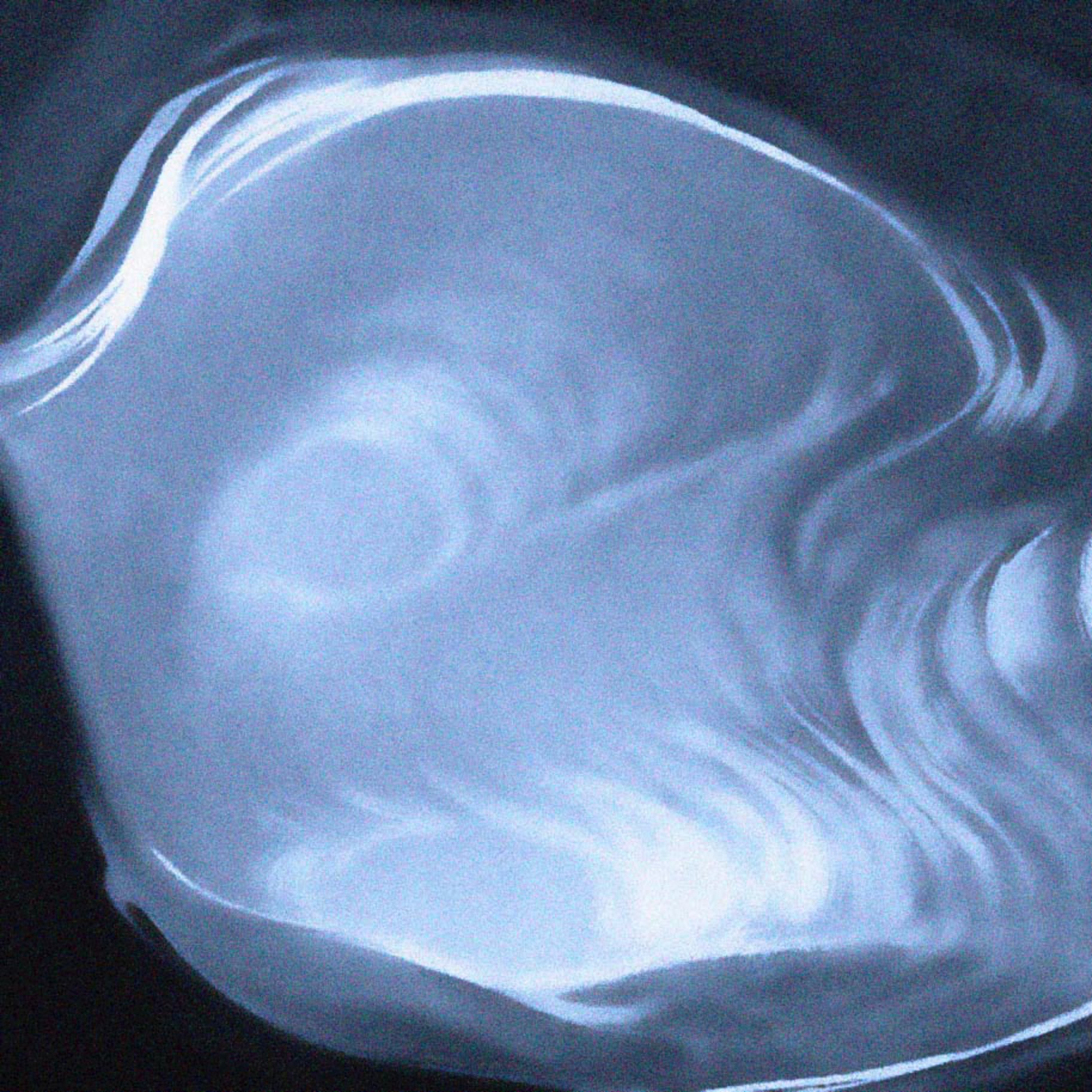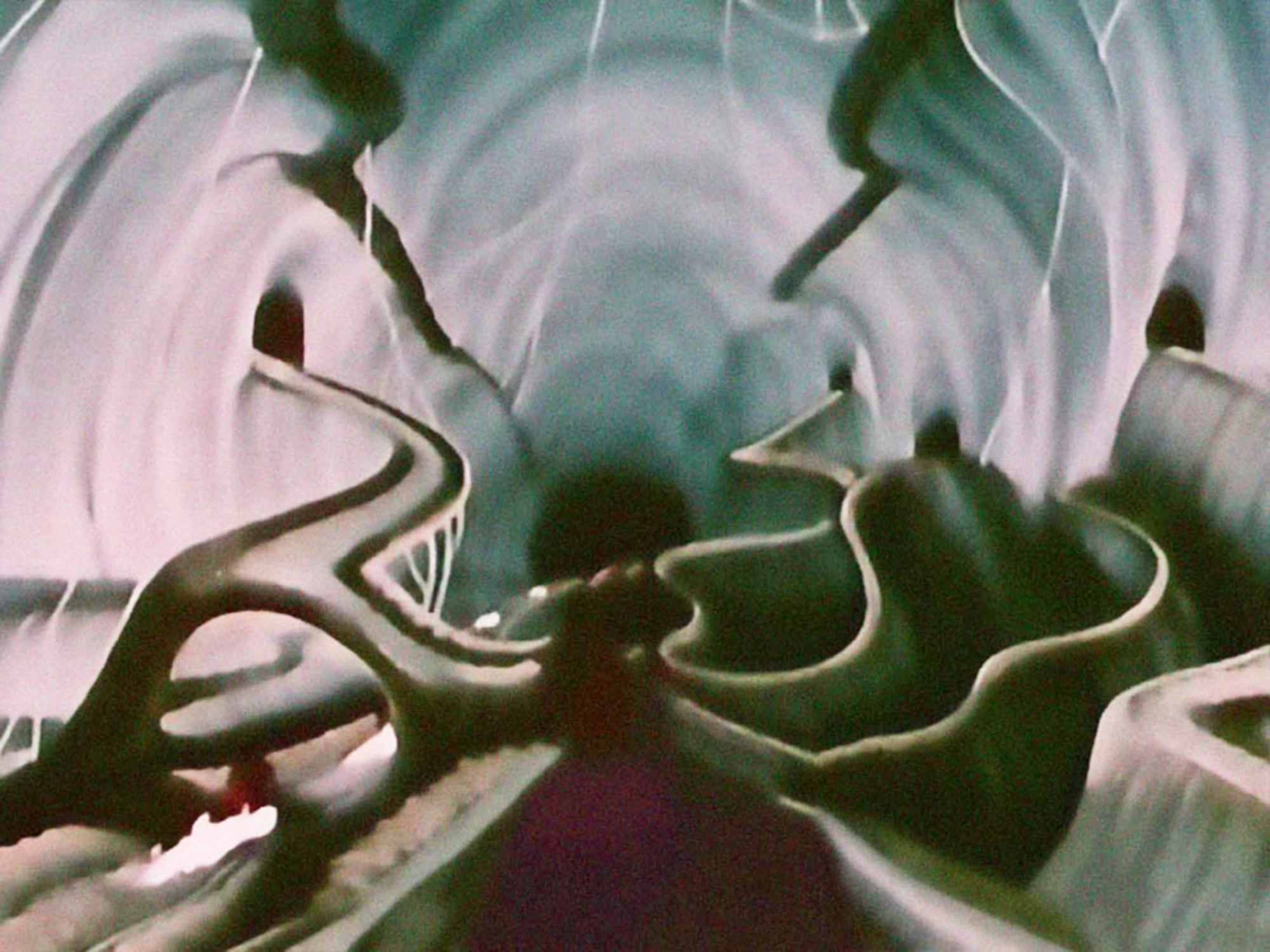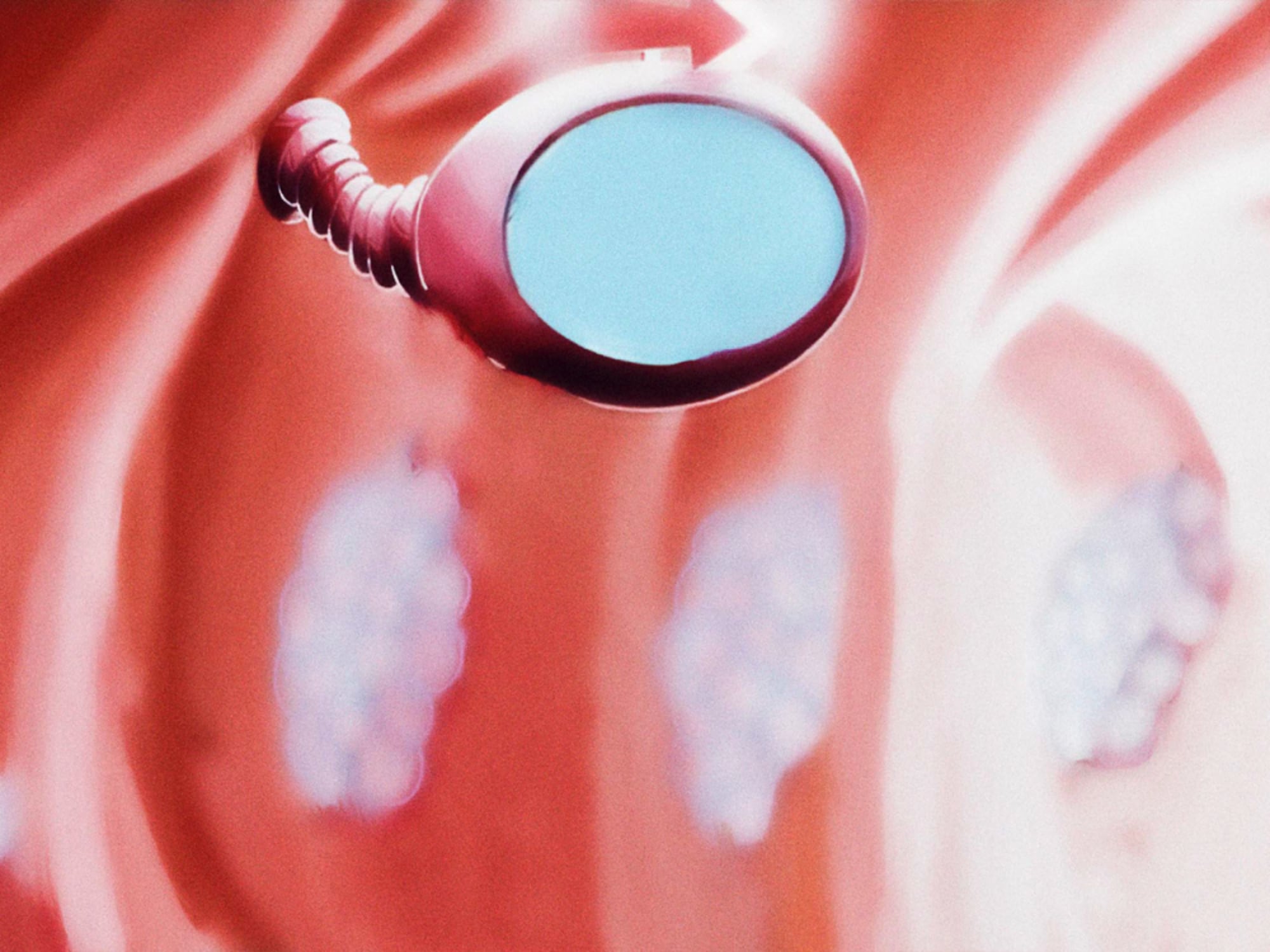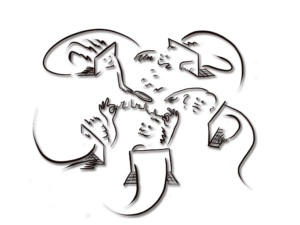
In Live Action Role-Playing (LARP) Games, players pursue goals within a fictional setting. This setting is landscaped through a real-world environment. The players interact with each other in character. LARP Games can be played in a multiplicity of settings (not solely performative art settings).
Through its evolution, Live Action Role-Playing has emerged as a new performative art form that collectively performs realities.
At Footnotes, FAST45 experimented with Live Action Role-Play as a method for futures thinking in art school and for art school futures.
Do you want to dive deeper into Live Action Role-Play? Jump to the LARP Glossary!

Footnotes is part of FAST45, a pan-European research project which aims to create and test new methodologies, envisage future scenarios, establish long-term international collaboration and develop tools and initiatives which will empower arts institutions not only to anticipate upon unknown futures, but to actively shape them, too.
At the Footnotes Summer School, FAST45, under the lead of School of Commons, invited artists, educators, students and researchers to travel into the year 2045 to explore the futures of arts education. Together participants tested Live Action Role-Play as a method for futures thinking in art school and for art school futures. The majority of participants had no previous knowledge of LARP.
The event was planned and executed in collaboration with two LARP artists (Carina Erdmann and Steph Holl-Trieu working as 0ct0p0s). Footnotes thus worked at the interface of futures thinking, higher arts education, LARP and research.
Following the Live Action Role-Play method, all participants assumed fictional characters for the duration of the Summer School and agreed on meeting in the (imagined) year of 2045.
The basic future scenario of the Footnotes gathering in the year 2045 formed the overall framework of the world in which the Footnotes participants would meet (see Backstory). This imagined setting was developed, supported and sustained by the FAST45 team and the LARP artists throughout the whole event. With the help of bodywork, guided meditations, games and many more interventions, Summer School participants were guided through their futures jump, and found themselves in a setting of a 2045 reality.
This setting was developed in a way that was concrete enough to guide participants’ imaginations and played into the same space, making it easy to arrive in but still open, so participants had space to form the 2045 world they were meeting in. The flexibility of the world we met in was strongly supported by the pre-stated understanding of time and space as flexible and fluid, and the overall idea and method of Worldbuilding or Worlding.
Speakers had been briefed on the basic setting for the future scenario in which we met and were invited to position their contributions in a speculative future. The talks thus supported the overall Worldbuilding process happening throughout the Summer School. Participants met in different focus groups. Each group concentrated on one part of the 2045 world. It thus was part of the workshops and lectures to develop detailed future realities for arts education in 2045, together.
Summer School participants had been introduced to the method of LARP before the start of summer school. They gained access to the digital meeting platform “Footnotes Learning Platform” where they were invited to learn about LARP and start developing the character they would want to bring to the Summer School. At the start of the Summer School the character building (Otherself) was playfully facilitated in-situ with the help of the LARP artists.
Overall, the event focused on the lived experience of embodying future realities of arts education with all of the senses, and in relation to others whilst actively shaping these futures. The sustained setting and the relational and collective Worldbuilding supported participants to realise this future jump, which is otherwise often difficult to conceive. Staying too anchored in the now is one of the biggest obstacles for creative futures thinking. The setting created through LARPing further supported the process of experiencing, embodying and immersing into the complex interconnections and infinite possibilities of our futures and the empowering realisation that we have the power to shape them.
The setting participants met at during Footnotes was carefully developed by the FAST45 team and the LARP artists. This setting needed to be accessible, flexible and, at the same time, support futures thinking.
The following is documentation gathered during the Footnotes Summer School which helps give an impression of the environment that was constructed throughout the event and that helped to realise a Summer School with diverse participants and contributors in a speculative 2045 setting, where the futures of art schools and arts education were designed.
... are definded a place of trans-temporal exchange.
Footnotes 👣 is a place of trans-temporal exchange. It recalls various practices that have historically activated the place of the margin, be it as a form of resistance found in feminist practices of critical pedagogy, the tradition of black radical thought, as artistic gesture from the 19th century, or as a form of intervention and conversation between different readers as seen in medieval scriptures. Annotation is mostly used in the Footnotes environment to subvert the Learning Platform and the knowledge body that was enlisted there.
... are understood as a processes of constant and continuous nurtue. Time is a product of collective experience. It is heterogeneous and never just speeds up or accelerates.
Temporal zones 🫧 are processes in need of constant and continuous nurture. Time is a product of collective experience. It is heterogeneous and never “just” speeds up or accelerates.
The trans-temporality of the Footnotes community has often made it difficult to pin down spatio-temporal borders, yet, from time to time a temporal zone can be held and used as a magnifying glass to understand where we are and where we’re going.
The 2045 Footnotes gathering will occur inside the temporal zone of 2045 at Toni Areal in Zürich.
Imerge into the backstory which formed the framework for the role-play.
It is the year 2045. This year’s Footnotes gathering will be hosted by the School of Commons. This meeting was named after a function within the Learning Platform, a tool devised in 2021 to facilitate knowledge and resource exchange, host digital learning formats (seminars, lectures, etc.), coordinate the use of physical resources (workshops, seminar rooms, technical equipment, etc.) and publish or present theoretical and artistic practices.
Slowly over the last 24 years, the platform was deployed globally across numerous Art and Design Schools. In some places, academies and educational institutions decided to repurpose and cut back on their financing of physical classrooms, studios, and workshops and invested heavily in digital infrastructures such as data centers and connectivity services. The reasoning was that needs-based rentals of workspaces and equipment would be far more economical than the maintenance of often centuries-old buildings. Of course, this was not the case everywhere. Other schools decided to use the Learning Platform ‘lightly’, emphasizing the need to meet and study in physical environments. Without a doubt, these different models emerged due to the changing and asymmetric educational policies adopted by regional, national and international governance bodies.
Yet over the entire time, another trend emerged, threading its way through faculties and institutions.
Footnotes, a standardized functionality hard-coded into the Learning Platform, grew into a buzzing place of transgenerational exchange. Initially thought to simply comment and annotate institutionally canonized corpora of knowledge, different working groups formed. In activating the space of the margin, these groups revisited feminist theories of critical pedagogy, the black radical tradition, decolonial methodologies, artistic gestures of subversion, and practices found in medieval scriptures to understand this place as one with a rich history of emancipatory struggle and resistance.
For more than twenty-two years now, the Footnotes function of the Learning Platform has become its own platform for individuals and working groups to discuss and organise around issues of arts education. Over time, many different conversations and threads emerged between the lines. These threads coalesced into working groups, in-person meetings, and larger gatherings of translocal exchange. In April 2045, one of these groups called the School of Commons put out a call for a gathering. It didn’t take long until seven engaged groups signed up. They called themselves: DIS/CONTINUITIES, ORGANOLOGY, CHAOS/MOSIS, COMMONALITIES, RE/PROGRAMMING, SYMBIOSIS, and PLASTICITY. Each group would explore its unique theme.
In a long message thread, the groups decided that there would be 2 ½ days dedicated to workshops, while the last 1 ½ days would host a conference. The latter would be committed to synthesizing the many discussions and thought forms that emerged over the last decades and were processed during the workshop sessions.
During the workshops, the groups will deepen the understanding of their research and practices, situating them both within their local environments and wider global developments.
Carving out new pathways for arts education and zones to nurture common bodies of knowledge builds on the efforts of many generations. Therefore some of the working groups will be annotating video lectures from future archives of the past. Others invited remote speakers to share experiences, provocations, and reflections from their own contexts and conditions.
Because not everyone will be able to attend, newfound insights will be shared through the Footnotes Channel, the shared knowledge base of Footnotes. In addition, those who are not able to attend will be remotely embodied by a real-life avatar, who will visit the different groups over the course of the workshops and transmit questions and comments.
In the end, this will all be an experiment, but one that will hopefully allow for Footnotes to walk all over the bodies of organised texts.
... is a growing archive that collects messages to the futures recorded at different moments in time to invoke a transtemporal conversation.
Futures Archive 🔎 is a growing video archive that collects messages to the futures recorded at different moments in time to invoke a transtemporal conversation.
The first seed for the Futures Archive was developed 27 years ago in 2018 by Manuela Zechner during a meeting in Barcelona. As Lina Dokuzović writes: “The Future Archive is a perspective and series of fictional interviews for reinterpreting the present from an imagined, desirable future. I began writing this by reflecting back on 2008 and the snowball effect produced by the austerity and fear of the financial crisis, as we began doing in the Barcelona meeting. If we look at the present from 2008, it’s perhaps not so surprising. In 2008, extreme austerity measures were becoming commonplace. Many new forms of web surveillance had become widespread after the 9/11 attacks. There was a broad sense of fear, anxiety, and paranoia. The US had an unfair election that outraged many people worldwide. And a new conservatism was dividing societies around the world. There are certainly differentiations, but that situation somehow doesn’t seem so different from what we are experiencing today. And not only did we survive that, but new mass movements, which were fighting against similar forms of oppression, rapidly expanded translocally and became more networked than ever before, leaving behind a wealth of knowledge on strategies and perspectives of struggle.
Today, we have become so inundated with fear that the left has been adopting strategies of fear-mongering, previously predominantly the domain of the right, to stimulate people into action. However, let us try to use these historical moments – rather than fear – for approaching our experiences and vulnerabilities as strengths rather than lack and as anchor-points for reimagining a desirable future: a reality where we use our translocal knowledges from feminist and queer collectives, migrant struggles, knowledge-based struggles, struggles for commons, struggles against displacement, and radical care practices; a reality where committees of poor and disenfranchised lead the decision and policy-making and where knowledges of struggle become more important than “alternative facts”; a reality in which our sense of self does not become destabilized but rather anchored through an exchange of our experiences of embodied struggle, knowledge-based struggles, struggles for commons, struggles against displacement, and radical care practices; a reality where committees of poor and disenfranchised lead the decision and policy-making. In a time when a constantly turbulent news cycle makes it more and more difficult to focus and to understand what is taking place around us, let us instead comprise a map of the nodes of past successes and failures, of our embodied and experiential knowledges, for revisiting and developing strategies of struggle in the present-day.”
The fictional setting of the summer school in 2045 was sustained throughout Footnotes. This was particularly important to support the immersive experiences of the participants. For this purpose, welcome speeches, general information etc were all framed as part of the fictive 2045 setting. Watch the Footnotes Opener to get an idea how this was done:
In order to take participants to the 2045 Footnotes setting we used multiple techniques. One was guided meditations and performances by the LARP artists Carina Erdmann and Steph Holl-Trieu (0ct0p0s) which illustrated and reinforced the context (the Footnotes world) and thus the starting point of the role play. At the same time, these meditative performances invited the audience to let go of the world they knew and loosen up concepts that hold us from rethinking the now and future. They specifically supported a softening of dominant and seemingly fixed ideas around the boundaries of time and space, taking the audience on a journey through unknown temporal zones. The performances thus invited the audience to transform into a state of endless possibilities.
Watch two of these meditative performances by 0ct0p0s:
Dive into speculative futures of arts education on seven specific topics created by the different Foontotes working groups as part of the Footnotes LARP:
Every part of the Footnotes summer school happened in the temporal zone of 2045. Hence we also created our summer school podcast in line with the LARP environment. Check out the PODPAST and explore more futures of arts education and experience how LARP can enhance embodied futures thinking 🤓🎧
Would you like to apply LARP for futures thinking in an event setting? Look into the Footnotes workshop facilitator playbook and gain some useful insights for your event.
TELL ME MOREHow was the event experienced?
What were astonishing moments?
What was maybe difficult?
Listen to some voices…

There are many conceptions of what the activity of ‘Worlding’ entails. It encompasses anything from the invention of fantastic cosmologies, utopias or futures you can believe in, to the formation of new reality systems and the active constructions of viable systemic alternatives. Footnotes will consider worlding as a way to critically reflect and rethink existing structures and practices within Arts Education.
‘Worlding’ is not automatically a critical practice. It initiated as a project for the colonization the “new world”, extending into the technocratic schemes of restructuring the world according to flows of capital and data accumulation. To move beyond such a world that is co-opted by hegemonial claims for (its) order, Footnotes takes the underlying theory of multiple worlds as a point of departure for exercises in Collective Worlding.
LARP inherently involves a form of collective worlding as players give shape to the fictional world and its narration through improvised actions. The Footnotes workshops will center this activity by creating a skeleton for the 2045 scenario whilst letting players ‘flesh out’ their collective vision. It will provide enabling structures within which players can spawn different words and explore their relations, conditions and consequences.
Once spawned Worlds have the ability to take a life of their own. But they are fragile entities and need the nurturing from their inhabitants to stay alive. It will be your role to care for the maintenance of the worlds and support players to uphold their suspension of disbelief. The best way to help players stay in the fiction is to set an example in taking their collective creation seriously and not breaking with your character except in the designated “safe space”.
Read more about Worlding: “Worlding” by Carina Erdmann
Relational Worlding shifts the focus from existence to co-existence. From defining where and what things are to how they are connected. Essential methods are zooming in and out from different scales, probing consequences to decisions made from different angles, and regarding all elements as entangled processes.
As a training ground for imaginative flexibility Footnotes fosters simultaneous stories and colliding worlds through the creation and negotiation of a shared gamespace. To revise a world means to look at it repeatedly in a new light. Worlding is also the process of the unmaking of the world: it requires us to rethink our relation to the environment and our own role within it.
Colliding worlds are confronting. Their crashing can make a mess in our shelf of convictions as it unravels the seams of our thinking fabric and yet, this is a proposal to embrace complexity, leaving the comfort of one’s own skull or self applauding filter bubble.
Once we have shattered the illusion of the universal, what are the implications of this such relativism for public and artistic discourse? How can we construct a common place in which multiple worlds inter-mingel instead of drifting apart in a fight about the centerstage?
Collective Worlding produces flexible, relational, opaque, incoherent (inter)subjectivities. It may open ourselves to other forms of knowing, reconnect us to our sensual and social bodies and lay foundations for new forms of cohabitation.

🪡 YARN is a method we use to remember the relations we have built between us.
We start off by sitting in a circle.
A ball of yarn is given to one of us. This person starts the conversation by throwing the yarn to someone else whom they want to remind of an experience or a shared memory.
This memory could be about something you did together: “Remember that time we went out for a drink and we came back two weeks later?” or it could capture a feeling “Whenever you enter the room I feel safe.”
Whoever receives the yarn responds to its sender
Based on the ‘yes…and’ technique, this person responds with an additional memory that builds on what was given to them. Or they draw up a conflicting element of the relation (yes…but)
“Yes, it was so wild, it reminded me of those games in which you swap a pen for a notebook and swap yourself up until you have a car. It really felt like we snowballed from one adventure to another.”
Or: “That’s funny because I never thought that you quite liked me.”
The person who received the yarn will now throw the yarn to someone else, strengthening another shared experience, relation or memory.
We will continue this exercise until everyone has received the yarn once and passed it on once.
Note: If the group has an even number of participants we will have to re-throw the yarn to a selected person to ensure everyone gets to sediment two relations with someone else in the group.
This is a resource of this practice that was written 26 years ago, yet still remains helpful 😉 https://nordiclarp.org/2019/03/29/your-alternate-relation-narrative-yarn/
…for collective world building.
“’Yes, and…’, also referred to as ‘Yes, and…’ thinking, is a rule-of-thumb in improvisational comedy that suggests that a participant should accept what another participant has stated (“yes”) and then expand on that line of thinking (“and”). It is also used in business and other organizations as a principle that improves the effectiveness of the brainstorming process, fosters effective communication, and encourages the free sharing of ideas.”
Building an Otherself for yourself is a crucial tool for accessing speculative narrative and design from an embodied and personal viewpoint that allows for a radical shift in perspective. How far away you want to move from your own experiential horizon is up to you. You can play ‘close to home’ and simply project yourself into the future, but you might also want to try out a different side of yourself or assume a temporary position that feels currently far away from your own.
In any case, take a moment for yourself to consider what themes and positions interest you when you think of the future of arts education. What are questions you feel curious or passionate about? This is the moment to assure that values and concerns that are important for you to figure out during the Footnotes Workshop will be included in the game play. Do not overthink it. Be intuitive.
For existing organizations or collectives it might be interesting to consider how you imagine your transformation or development in the future.
Role Sheet
ROLE SHEET
⚙ Take about 30 minutes to start constructing the bare bones of your Otherself.
Try to use the time between now and the workshop and conference to get to know your Otherself better. You can start by writing a diary as your Otherself, or by creating a wardrobe for them.
Take a piece of paper, note down your answers and treat this as your Otherself’s memory.
Once you’ve done this, write a short bio for your Otherself.
In relation to the theme you want to work on during the Summer School:
What is the character’s history with this theme?
Has the character worked on this topic before?
Is there a memory, or story this character associates with the theme?
In role-playing “bleed” is what happens when real-life experiences, emotions, thoughts, relationships, perceptions and physical states spill over into their characters’ and vice versa. In some examples of game design, the idea is to reduce bleed to a minimum. However, for Footnotes, we believe that moments of bleed can be helpful and shouldn’t be fought against. Instead, we want to use bleed to understand what is possible if we temporarily disassociate from the here and now, and then return to the present and consensual reality to understand the constraints and conflicts imposed on what is possible.
Although we don’t expect this game to trigger any emotional or psychological trauma, we cannot rule it out. For this reason, we want to propose the use of a code word, which allows players to go up to other players and momentarily leave the game and go to a quiet spot, where they can share what is troubling them. The idea is that in that smaller group they can together find a way of mediating the situation.
Our suggested Code word is “Safer Space”, but feel free to agreed upon your own.
Otherselves (like emergent worlds) are fragile beings. Here are some general tips to make your Otherselves feel as comfortable as possible and prevent them from going into hiding:
Dive deeper
Discussion
No feedback has been added yet
Share a Thought